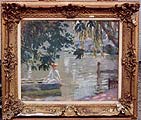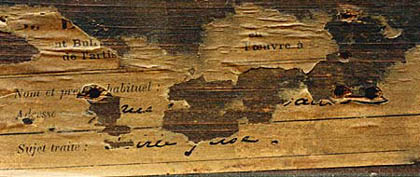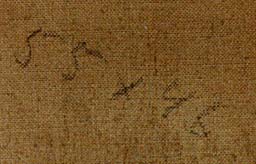|

Click for larger image of the whole frame
This ornament-frame has been used before, but
it is the "original" for our River-scene. The two others also carry
frames that have been used before. These are however also the
’originals’ chosen for our paintings. In fact it showed that none of
the paintings had ever been taken out of their frames before our
restorers did. This means that they spent over 100 years untouched
by restorers, according to our theories, since 1899, the year when
Suzanne dies.
The River-scene and the Garden-scene were, to
put it mildly, extremely dirty and covered by a deep brown varnish.
Unfortunately the film, that was taken before and during the
restoring, was destroyed by accident. Some photos from the restoring
of the Meadow-scene ’survived’. This canvas was also very dirty, but
not at the least as dirty as the two others. (See
photo below).

Click for larger photo
We notice the white inner border of the frame
and recognize the impressionist touch and taste. We know that some
of the impressionists sometimes even preferred old ornamnent frames
all white, with the gilt totally rubbed off. Looking closer we can
easily see what has happened here. The original gilt of the inner
border has been rubbed and scraped off. The frame was
’modernized’ to the taste of the time! Having found out this, we
might even have found out the meaning of the two letters ’PM’ found
written in pencil on this frame and perhaps probably corresponding
to and being short for ’P Moderne’ written by the same hand on
the back of the frame belonging to The Garden scene. If this
stands for ’pas moderne’ meaning that this frame was not ’modern’ -
according to Monet´s opinion – this is the way of writing this to be
remembered by the man who had the responsibility for the maintanance
of this part of the ’picturemaking–industry’.

French label
There are many reasons to believe that this
label is the original exhibition label for the first version of our
River-scene! We have already studied the small rose reminiscences
looking out from beneath the paint-layers of the second version of
today. "Sujet traite: Soirée ..-se" - rose? The light from the
setting sun was certainly rose and the time for the painting session
certainly Soirée.
Certainly a title with impressionistic character, but we have not
yet, been able to find out wether used by Monet or not. Perhaps
someone can identify this label. Perhaps there might exist a
catalogue?
Please observe all the holes after screws - the frame has been
used as exhbition frame after the label was glued on. There are
holes on all four sides and it might have been used at least six
times according to holes matching each other.
We also read "53 E.." (Exposiiton?) -ent
Bul.. probably the address for the Exhibition.
Concerning frames John House writes: ”Later he accumulated his
own stock of frames of various sizes at Giverny. ” (p.181). ”; the
frames at Giverny can be seen at film taken there by John Read
in summer 1975.” (Ch 10 note 28).
What happened to these frames?
Please let me know!
Since we have so many annotations, exactly alike
written by the same hand, on all the three frames it would of course
be very exiting to have the chance to examine these frames that
still were at Giverny in 1975! Where are they now? Somebody
must know?
5)

The written text 'creus' (?) and 'pm'
On the frame is also written, in pencil,
‘PM’. On the frame of the ‘Meadow scene’ it is written: ‘PM’,
probably PM here is short for P Moderne?
What this means we certainly would like to find out. We suppose that
somewhere, there must be other frames with the same script.
6)

On the back of the canvas is the size of it,
written in pencil. This is done in
the same way on all the three canvases – by the same hand. Here it
is: ‘55x46’. This handwriting should also be possible to
identify on other canvases.
We know that Monet got help with the frame work
from his chauffeur. According to our theory, these paintings are
framed when Suzanne dies in 1899. Paintings executed from around
this year might have similar measuring figures.
Press HERE for next page
|